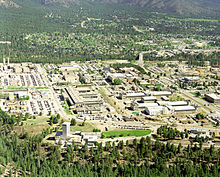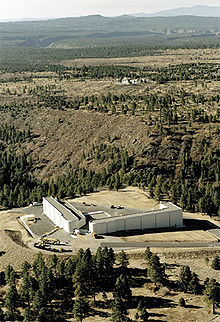- Los Alamos National Laboratory
-
Das Los Alamos National Laboratory (LANL, früher auch Los Alamos Laboratory oder Los Alamos Scientific Laboratory) ist eine Forschungseinrichtung der US-amerikanischen Regierung in Los Alamos, New Mexico.
Sie wird von der University of California für die NNSA (National Nuclear Security Administration) des United States Department of Energy (DOE) betrieben. Zur NNSA gehören auch die Sandia National Laboratories in Albuquerque (New Mexico) und das Lawrence Livermore National Laboratory in Livermore.
Los Alamos ist in erster Linie ein Kernforschungszentrum, das dadurch bekannt wurde, dass hier das Atomwaffenprogramm der US-Regierung begonnen und die erste Atombombe während des Manhattan-Projekts entwickelt wurde.
In den 1940er und 1950er Jahren ereigneten sich in Los Alamos drei Atomunfälle mit tödlichen Folgen, zwei davon mit demselben Plutoniumkern, dem sogenannten Demon Core (INES: 4[1]).
Heute ist das Los Alamos National Laboratory eine Forschungseinrichtung, in der neben dem Stockpile-Stewardship-Programm zur Erhaltung der vorhandenen Nuklearwaffen auch Grundlagenforschung auf den Gebieten Physik, Chemie, Biologie und Mathematik betrieben wird. Es beherbergt eines der größten Institute für theoretische Forschung der Welt und hat insgesamt mehr als 6000 Mitarbeiter. Es liegt abgelegen etwa 60 km nordwestlich von Santa Fe, New Mexico, auf einer Mesa (Hochebene) in etwa 2500 m Höhe.
Teile des Gebietes sind weiterhin militärische Sperrzone.
1972 wurde in Los Alamos der damals leistungsstärkste Protonen-Linearbeschleuniger im LAMPF (Los Alamos Meson Physics Facility) in Betrieb genommen (Endenergie 800 MeV bei einer Wiederholungsrate von 120 pro Sekunde und einem mittleren Strom von einem mA), mit dem hauptsächlich kernphysikalische Untersuchungen durchgeführt wurden. Parallel dazu wurde die WNR-Anlage (Weapons Neutron Research) gebaut, die intensive Flüsse hochenergetischer Neutronen für die Untersuchung der Nuklearbombenphysik zur Verfügung stellte. Beide Anlagen sind seit den 1990er Jahren im LANSCE (Los Alamos Neutron Science Center) integriert, das eine Spallationsneutronenquelle für eine breitgefächerte Reihe von Anwendungsgebieten zur Verfügung stellt.
Von 1993 bis 1998 fand hier das LSND-Experiment zur Neutrinooszillation statt.
Am 8. Juni 2008 wurde im Los Alamos National Laboratory der einstmals schnellste Supercomputer der Welt, der IBM Roadrunner in Betrieb genommen.
Am 27. Juni 2011 wurde die Anlage wegen Buschbränden geschlossen[2], die Stadt selbst evakuiert. In Los Alamos werden unter anderem zehntausende Fässer mit radioaktivem Müll gelagert.[3]
Weniger als einen Monat später erzeugte ein Forscherteam des Labors das weltweit stärkste Magnetfeld, welches von nicht-destruktiven Magneten generiert wurde. Am 18. August brachen sie mit 92,5 Tesla[4] den Weltrekord, den zuvor das Helmholtz-Zentrum Dresden-Rossendorf innehatte und konnten ihn am kommenden Tag auf 97,4 Tesla erhöhen.
Siehe auch: arXiv
Weblinks
 Commons: Los Alamos National Laboratory – Album mit Bildern und/oder Videos und Audiodateien
Commons: Los Alamos National Laboratory – Album mit Bildern und/oder Videos und Audiodateien- Website des Los Alamos National Laboratory
- Zum 30jährigen Jubiläum von LAMPF 2002 und seinem Entwickler Louis Rosen
- Sonderheft Los Alamos Science zu 50jährigem Bestehen
- Sonderheft Los Alamos Science zu 60jährigem Bestehen 2003
- Los Alamos Science 1983 zur Geschichte des Labors
35.875822222222-106.32282777778Koordinaten: 35° 52′ 33″ N, 106° 19′ 22″ WEinzelnachweise
- ↑ The Atomic Heritage Foundation Accidents in the Manhattan Project
- ↑ Flammen bedrohen US-Atomlabor. Meldung bei spiegel.de vom 27. Juni 2011.
- ↑ Buschbrände in Los Alamos breiten sich weiter aus. Meldung bei tagesschau.de vom 2. Juli 2011.
- ↑ James E. Rickman: Los Alamos achieves world-record pulsed magnetic field. National High Magnetic Field Laboratory moves closer to 100-tesla mark. Newsmeldung des Los Alamos National Laboratory (LANL) vom 23. August 2011.
Kategorien:- Nuklearforschungszentrum
- Energieministerium der Vereinigten Staaten
- Militärische Einrichtung in New Mexico
- National Historic Landmark (New Mexico)
- Militärische kerntechnische Anlage
Wikimedia Foundation.



